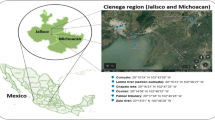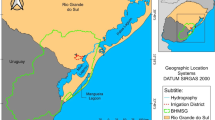Abstract
Pollution of drinking water sources with agrochemicals is often a major threat to human and ecosystem health in some river deltas, where agricultural production must meet the requirements of national food security or export aspirations. This study was performed to survey the use of different drinking water sources and their pollution with pesticides in order to inform on potential exposure sources to pesticides in rural areas of the Mekong River delta, Vietnam. The field work comprised both household surveys and monitoring of 15 frequently used pesticide active ingredients in different water sources used for drinking (surface water, groundwater, water at public pumping stations, surface water chemically treated at household level, harvested rainwater, and bottled water). Our research also considered the surrounding land use systems as well as the cropping seasons. Improper pesticide storage and waste disposal as well as inadequate personal protection during pesticide handling and application were widespread amongst the interviewed households, with little overall risk awareness for human and environmental health. The results show that despite the local differences in the amount and frequency of pesticides applied, pesticide pollution was ubiquitous. Isoprothiolane (max. concentration 8.49 μg L−1), fenobucarb (max. 2.32 μg L−1), and fipronil (max. 0.41 μg L−1) were detected in almost all analyzed water samples (98 % of all surface samples contained isoprothiolane, for instance). Other pesticides quantified comprised butachlor, pretilachlor, propiconazole, hexaconazole, difenoconazole, cypermethrin, fenoxapro-p-ethyl, tebuconazole, trifloxystrobin, azoxystrobin, quinalphos, and thiamethoxam. Among the studied water sources, concentrations were highest in canal waters. Pesticide concentrations varied with cropping season but did not diminish through the year. Even in harvested rainwater or purchased bottled water, up to 12 different pesticides were detected at concentrations exceeding the European Commission’s parametric guideline values for individual or total pesticides in drinking water (0.1 and 0.5 μg L−1; respectively). The highest total pesticide concentration quantified in bottled water samples was 1.38 μg L−1. Overall, we failed to identify a clean water source in the Mekong Delta with respect to pesticide pollution. It is therefore urgent to understand further and address drinking water-related health risk issues in the region.


Similar content being viewed by others
References
Alavanja MCR, Hoppin JA, Kamel F (2004) Health effects of chronic pesticide exposure: cancer and neurotoxicity. Annu Rev Public Health 25:155–197
Aldreu V, Picó Y (2004) Determination of pesticides and their degradation products in soil: critical review and comparison of methods. TrAC-Trend Anal Chem 23(10–11):772–789
Bayer CropScience (2014) SAFETY DATA SHEET according to Regulation (EC) No. 1907/2006. http://www.interfarm.co.uk/DownloadFile.ashx?FileId=414
Berg H (2001) Pesticide use in rice and rice–fish farms in the Mekong Delta, Vietnam. Crop Prot 20:897–905
Berg H, Tam NT (2012) Use of pesticides and attitude to pest management strategies among rice and rice-fish farmers in the Mekong Delta, Vietnam. Int J Pest Manag 58(2):153–164
Berg M, Stengel C, Trang PTK, Pham HV, Sampson ML, Leng M (2007) Magnitude of arsenic pollution in the Mekong and Red River Deltas—Cambodia and Vietnam. Sci Total Environ 372:413–425
Buschmann J, Berg M, Stengel C, Winkel L, Sampson ML, Trang PTK, Viet PH (2008) Contamination of drinking water resources in the Mekong Delta floodplains: arsenic and other trace metals pose serious health risks to population. Environ Int 34:756–764
DONRE Can Tho (2009) A ten-year report 1998–2008 of Department of Natural resources and Environment of Can Tho City (in Vietnamese), pp 26–31
Carvalho FP, Villeneuve JP, Cattini C, Tolosa I, Thuan DD, Nhan DD (2008) Agrochemical and polychlorobyphenyl (PCB) residues in the Mekong River delta, Vietnam. Mar Pollut Bull 56:1476–1485
Chi TTN, Hossain M, Palis F (2004) Impact of integrated pest management-farmer field school (IPM-FFS) on farmers’ insect pest management belief, attitude and practices (KAP) in Vietnam. Omonrice 12:109–119
Danh VT (2008) Household switching behavior in the use of groundwater in the Mekong Delta, Vietnam. Economy and Environment Program for Southeast Asia (EEPSEA). Research report. http://www.eepsea.net/pub/rr/12312287701Danh_RR3.pdf
Delta Alliance (2011) Mekong Delta water resources assessment studies. Vietnam–Netherlands Mekong Delta Masterplan Project 2011. Deltares, Delft, p 43
Dung NH, and Dung TTT (1999) Economic and health consequences of pesticide use in paddy production in the Mekong Delta, Vietnam. Economy and Environment program for Southeast Asia, Research report. http://idl-bnc.idrc.ca/dspace/bitstream/10625/25143/10/113557.pdf
EC (1998) European Commission. Council Directive 98/83/EC of 3 November 1998 on the quality of water intended for human consumption. Official Journal of the European Communities 330:32–54. Off J Eur Communities L 330:32–54
EC (2003) European Commission. Review report for the active substance trifloxystrobin. http://ec.europa.eu/food/plant/protection/evaluation/newactive/list1-18_en.pdf
Estellès P, Jensen H, Sánchez L, Vechiu G (2002) Sustainable development in the Mekong Delta. Center for Environmental Studies, Denmark, pp 28–29
GSO (2008) General Statistics Office. Results of the survey on household living standards 2008. General Statistic Office. Statistical publishing house, Vietnam
GSO (2013) General Statistics Office. Statistical yearbook of Vietnam 2012. Statistical Publishing House, Vietnam
Gupta PK (2004) Pesticide exposure—Indian scene. Toxicology 198(1–3):83–90
Hamilton DJ, Ambrus Á, Dieterle RM, Felsot AS, Harris CA et al (2003) Regulatory limits for pesticide residues in water (IUPAC Technical report). Pure Appl Chem 75(8):1123–1155
Heong KL, Escalada MM, Huan NH, Chien HV, Quynh PV (2010) Scaling out communication to rural farmers: lessons from the “Three Reductions, Three Gains” campaign in Vietnam. In: Palis FG, Singleton GR, Casimero MC, Hardy B (eds) Research to impact: case studies for natural resource management for irrigated rice in Asia. International Rice Research Institute, Los Baños, pp 207–220, http://ricehoppers.net/wp-content/uploads/2010/11/13-Heong-et-al.pdf
Hien NX (2009) The natural resources of the Vietnamese Mekong Delta. J Water Resour Sci Technol 1910/VL:24–32, in Vietnamese
Hobbs J (2003) Incentives for the adoption of Good Agricultural Practices. Background paper for the FAO Expert Consultation on a Good Agricultural Practice approach. FAO GAP working paper series 3. http://www.fao.org/prods/gap/Docs/PDF/3-IncentiveAdoptionGoodAgrEXTERNAL.pdf
Hoi PV, Mol A, Oosterveer P (2013) State governance of pesticide use and trade in Vietnam. NJAS - Wagen J Life Sc 67:19–26
IUPAC (2009) International of pure and applied chemistry. http://sitem.herts.ac.uk/aeru/iupac/index.htm
Kortenkamp A, Backhaus T, Faust M (2009) State of the art report on mixture toxicity. Final report of a project on mixture toxicology and ecotoxicology commissioned by the European Commission, DG Environment
Laabs V, Wehrhan A, Pinto A, Dores E, Amelung W (2007) Pesticide fate in tropical wetlands of Brazil: an aquatic microcosm study under semi-field conditions. Chemosphere 67:975–989
Maher I, Hetrick J, Thuy N, Andrews N (2006) Amended tebuconazole (parent only) drinking water assessment in support of registration actions for uses on turf, ornamentals, almonds, asparagus, barley, beans, corn (foliar and seed treatment), cotton, cucurbits, bulb vegetables, leafy brassica greens, garden beets, hops, lychee, okra, pecan, pistachio, pome fruit, soybean, stone fruit (except cherries), sunflower, turnip, and wheat. United States Environmental Protection Agency. http://ec.europa.eu/food/plant/protection/evaluation/newactive/list1-18_en.pdf
Milliman JD, Meade RH (1983) World-wide delivery of river sediment to the oceans. J Geol 91:1–21
MRC (2009) Mekong River Commission. The flow of the Mekong. MRC Management Information booklet series 2009. http://www.mrcmekong.org/assets/Publications/report-management-develop/MRC-IM-No2-the-flow-of-the-mekong.pdf
Özdemir S, Elliott M, Brown J, Nam PK, Hien VT, Sobsey MD (2011) Rainwater harvesting practices and attitudes in the Mekong Delta of Vietnam. J Water, Sanitation Hyg Dev 1(3):171–177
QCVN 01:2009/BYT (2009) Circular enforced on “National Technical Regulation on Drinking Water Quality”. Ministry of Health, Vietnam
QCVN 6–1:2010/BYT (2010) Vietnam’s National technical regulation for bottled/packaged natural mineral waters and drinking waters. Ministry of Health, Vietnam
Reis N, Mollinga PP (2012) Water supply or ‘beautiful latrines’? Microcredit for Rural Water Supply and Sanitation in the Mekong Delta, Vietnam. ASEAS – Austrian J South-East Asian Stud 5(1):10–29
Resolution 63/NQ-CP (2009) Resolution on national food security, Hanoi, Vietnam. http://www.isgmard.org.vn/VHDocs/NationalPrograms/Resolution%2063_Food%20security_EN.pDF
Ripp J (1996) Analytical detection limit guidance and Laboratory Guide for Determining Method Detection Limits. Wisconsin Department of Natural Resources. Laboratory Certification Program, USA
Sebesvari Z, Huong LTT, Toan PV, Arnold U, Renaud FG (2012) Agriculture and water quality in the Vietnamese Mekong Delta. In: Renaud FG, Kuenzer C (eds) The Mekong Delta system: interdisciplinary analyses of a river delta, Springer Environmental Science and Engineering, pp 331–362
Sinh NN, Thuy LTB, Kinh NK, Thang LB (1999) The persistent organic pollutants and their management in Vietnam. In: Proceedings of the Regional Workshop on the Management of Persistent Organic Pollutants (POPs), United Nations Environment Program, Hanoi, Vietnam, pp 385–406
Tanaka K (1995) Transformation of rice-based cropping patterns in the Mekong Delta: from intensification to diversification. Southeast Asian Stud 33(3):81–96
Tang Z, Ramanarayanan TS (2006) Modeling fate and transport of fipronil and its metabolites in surface water following application of chipco Topchoice@ to Turf. Sponsored by Bayer Crop Science, RTP, NC. Performed by Bayer Crop Science, Stillwell, KS, MRID 46936103. http://www.epa.gov/pesticides/chem_search/cleared_reviews/csr_PC-129121_2-May-08_a.pdf
Thuy PT, Anh NV, van der Bruggen B (2012a). Evaluation of two low-cost-high-performance adsorbent materials in the waste-to-product approach for the removal of pesticides from drinking water. Clean (3):246–253
Thuy PT, Van Geluwe S, Nguyen VA, Van der Bruggen B (2012b) Current pesticide practices and environmental issues in Vietnam: management challenges for sustainable use of pesticides for tropical crops in (South-East) Asia to avoid environmental pollution. J Mater Cycles Waste 14:379–387
Toan PV, Sebesvari Z, Bläsing M, Rosendahl I, Renaud FG (2013) Pesticide management and their residues in sediments and surface and drinking water in the Mekong Delta, Vietnam. Sci Total Environ 452–453:28–39
US EPA (2011) U. S. Environmental Protection Agency. Finalization of guidance on incorporation of water treatment effects on pesticide removal and transformations in drinking water exposure assessments. http://www.epa.gov/pesticides/science/efed/policy_guidance/team_authors/water_quality_tech_team/wqtt_dw_treatment_effects_removal_transformation.htm
US EPA (2014) U. S. Environmental Protection Agency. Aquatic life benchmark table. http://www.epa.gov/oppefed1/ecorisk_ders/aquatic_life_benchmark.htm
Wagner F, Vuong BT, Renaud FG (2012) Groundwater resources in the Mekong Delta: availability, utilization and risks. In: Renaud FG, Kuenzer C (eds). The Mekong Delta system: interdisciplinary analyses of a river delta, Springer Environmental Science and Engineering, pp 201–220
WHO (2010a) World health organization. Water for health. WHO guidelines for drinking water quality. http://www.who.int/water_sanitation_health/WHS_WWD2010_guidelines_2010_6_en.pdf?ua=1
WHO (2010b) World Health Organization. The WHO recommended classification of pesticides by hazard and guidelines to classification 2009. Geneva: International Program on Chemical Safety (IPCS) & World Health Organization (WHO); http://www.who.int/ipcs/publications/pesticides_hazard_2009.pdf
Wilbers GJ, Sebesvari Z, Rechenburg A, Renaud FG (2013) Effects of local and spatial conditions on the quality of harvested rainwater in the Mekong Delta, Vietnam. Environ Pollut 182:225–232
Wilbers GJ, Becker M, Nga LT, Sebesvari Z, Renaud FG (2014) Spatial and temporal variability of surface water pollution in the Mekong Delta, Vietnam. Sci Total Environ 485–486:653–665
Acknowledgment
The research was funded by the Federal Ministry of Education and Research (BMBF), Germany through the Water-related Information System for the Sustainable Development of the Mekong Delta (WISDOM) project in Vietnam. The authors would like to thank the Advanced Laboratory, Can Tho University for making use of their facility and their support during sample preparation. We are also grateful to the Center for Drugs, Cosmetics and Food quality control, Thua Thien Hue Province for their support in method development and sample measurement. We would also like to thank the DONRE of Can Tho for their cooperation. We are very grateful to the comments from four anonymous reviewers who have allowed us to improve our manuscript.
Author information
Authors and Affiliations
Corresponding author
Additional information
Responsible editor: Hongwen Sun
Electronic supplementary material
Below is the link to the electronic supplementary material.
ESM 1
(DOCX 46 kb)
Rights and permissions
About this article
Cite this article
Chau, N.D.G., Sebesvari, Z., Amelung, W. et al. Pesticide pollution of multiple drinking water sources in the Mekong Delta, Vietnam: evidence from two provinces. Environ Sci Pollut Res 22, 9042–9058 (2015). https://doi.org/10.1007/s11356-014-4034-x
Received:
Accepted:
Published:
Issue Date:
DOI: https://doi.org/10.1007/s11356-014-4034-x




